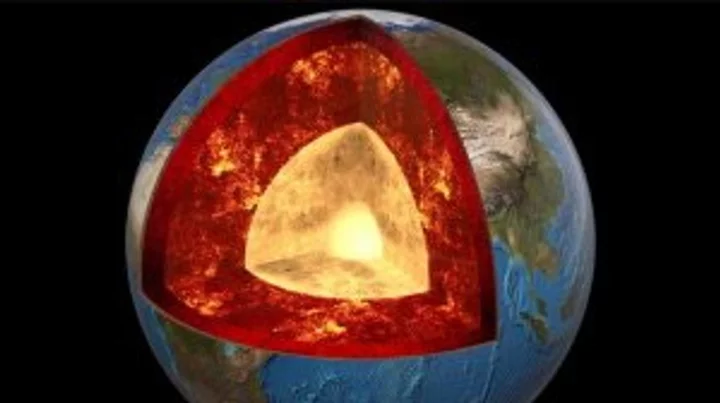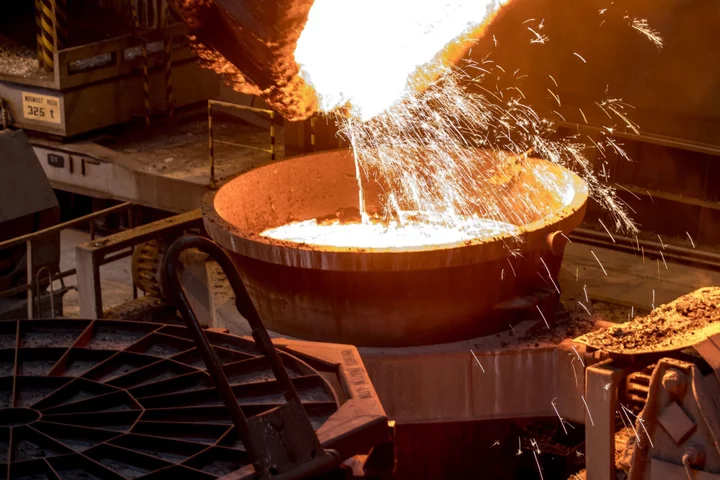
7 of History’s Strangest Mass Hysteria Events
Whether an entire town can’t stop dancing or people suddenly start worrying about minor marks on their windshields, these seemingly unbelievable events have had some surprising (and sometimes devastating) effects.
2023-06-12 20:22

Giant Richard Ayoade appears in Fable trailer
Fans are yet to receive a release date for the latest reboot in the popular action series.
2023-06-12 20:22

US, Canada Cities Risk Smoke as Fires Still Burn: Weather Watch
The air quality is in the moderate range across most of the US Northeast and parts of Canada,
2023-06-12 20:19

Ubisoft announces the first open-world Star Wars game
'Star Wars: Outlaws' is coming next year and gives players the chance to play as clever scoundrel Kay Vess.
2023-06-12 20:18

Shell CEO’s New Strategy Sees a Long-Term Future for Natural Gas
Shell Plc sees a long-term role for natural gas in the world’s energy mix and aims to expand
2023-06-12 18:19

Nasdaq to buy financial software firm Adenza for $10.5 billion - WSJ
Nasdaq will buy financial software firm Adenza for $10.5 billion in a cash and stock deal, the Wall
2023-06-12 17:59

Two giant structures deep within the Earth could be the remains of an ancient planet
Many of us look to the stars for answers to life’s most complex questions. But actually, some of the greatest mysteries lie beneath our very feet. One might think we’d know the Earth pretty well by now but, in fact, our planet’s core remains shrouded in enigma. Indeed, there are two gigantic blobs located beneath Africa and the Pacific Ocean that occupy around six per cent of the world’s entire volume. And yet, we’re still not entirely sure what they’re made of or where they came from. There are a number of hypotheses, including that they are piles of oceanic crust that have accumulated over billions of years. Sign up for our free Indy100 weekly newsletter But a more interesting theory is that they are huge chunks of an ancient planet that hit the Earth around 4.5 billion years ago. To give an indication of just how massive these things are, the structure under Africa – an area known as Tuzo – is thought to be around 800km (497 miles) tall – the equivalent of some 90 Mount Everests stacked on top of one another, as IFLScience notes. The problem with determining the origin of these monster formations is that there are no direct ways of observing the Earth’s core. The deepest hole humans have ever dug – branded the "entrance to hell" – reached a pretty staggering 12,263m (40,230ft), but that doesn’t even come close to breaking through the crust to the layers beneath. Our most effective tool for analysing what lies beneath the ground is a technique called seismic tomography, which looks at how waves of energy travel when earthquakes occur. Since rocks and liquids have different densities, the waves move through them at different speeds. By measuring the tremors from different points on the surface, geologists can determine what kind of material the waves are travelling through and, in so doing, map out the Earth’s interior. It was by using this technique that the two unusual structures – known as large low shear velocity provinces (LLSVPs) – were found. Waves travel more slowly in these areas – fondly known as “blobs” – than through the surrounding lower mantle, indicating that they’re made of something different. We can’t tell what this material is based on seismic tomography data alone, but some scientists like to believe that they are the remnants of an ancient planet called Theia – an idea known as the “giant impact hypothesis”. According to this hypothesis, around 4.5 billion years ago, a Mars-sized object collided with the Earth. This impact not only created the planet we call home today, but also threw off enough rock to form the moon that lights up our night skies. Some scientists suggest that some of Theia’s leftovers also sunk to the bottom of the planet, probably settling somewhere above the core – thereby forming at least one of the two LLSVPs. More Updates About Strange Blob Structures Inside Planet Earth youtu.be Experts have been investigating the area for decades but there’s still no way of knowing for sure just what these two giant blobs are. Still, studies into Theia have offered important insights into how the possible collision might have kickstarted key plate tectonic and mantle motion inside our planet – crucial processes for establishing the world on which we live. It’s also a useful reminder that we still have so much to learn about our planet and where we came from. Have your say in our news democracy. Click the upvote icon at the top of the page to help raise this article through the indy100 rankings.
2023-06-12 16:46

Massive ocean discovered beneath the Earth's crust containing more water than on the surface
It feels like there have been staggering science stories emerging every other day recently, all of which have blown our tiny little minds. First, there was the discovery of a terrifying black hole pointing right at us, then there was a huge hole found in the sun and a missing continent found after going missing for 375 years. Now, people are only just realising that there’s a massive ocean hidden under the Earth’s crust. It turns out there’s a huge supply of water 400 miles underground stored in rock known as 'ringwoodite'. Sign up to our new free Indy100 weekly newsletter Scientists previously discovered that water is stored inside mantle rock in a sponge-like state, which isn’t a liquid, solid or a gas, but instead a fourth state. The scientific paper titled ‘Dehydration melting at the top of the lower mantle’ was published in 2014 and laid out the findings. "The ringwoodite is like a sponge, soaking up water, there is something very special about the crystal structure of ringwoodite that allows it to attract hydrogen and trap water," said geophysicist Steve Jacobsen at the time. "This mineral can contain a lot of water under conditions of the deep mantle,” added Jacobsen, who was part of the team behind the discovery. He added: "I think we are finally seeing evidence for a whole-Earth water cycle, which may help explain the vast amount of liquid water on the surface of our habitable planet. Scientists have been looking for this missing deep water for decades." Scientists made the findings at the time after studying earthquakes and discovering that seismometers were picking up shockwaves under the surface of the Earth. From that, they were able to establish that the water was being held in the rock known as ringwoodite. If the rock contained just 1 per cent water, it would mean that there is three times more water under the surface of the Earth than there is in the oceans on the surface. Have your say in our news democracy. Click the upvote icon at the top of the page to help raise this article through the indy100 rankings.
2023-06-12 15:25

Every blue eyed person on the planet is a descendant of one single person
Blue eyed people listen up. Ever wondered why your eyes are the colour they are? Well wonder no more. Every blue eyed person is descended from a single European who lived around 6,000 to 10,000 years ago, according to scientists. How did they work it out? Originally, all humans had brown eyes in various shades until there was a specific mutation that made the change. The mutation is a gene called HERC2 and it switches off OCA2, the gene that determines how much brown pigment we make. Sign up to our free Indy100 weekly newsletter So that's why eyes become blue. As for being descended from the same person, the evidence for this is because every blue eyed person alive today has this same mutation. Scientists reckon only 8 to 10 per cent of the population have blue eyes and eyes don't fully develop in childhood meaning the brown pigment can kick in later, causing blue eyed children to end up with brown eyes in adulthood. So if you have blue eyes, now you know - your family is a lot bigger than you might have thought previously. Have your say in our news democracy. Click the upvote icon at the top of the page to help raise this article through the indy100 rankings.
2023-06-12 15:23

Ancient formation discovered wrapped around Earth's core
The structure of the Earth beneath our feet has been fascinating to members of the scientific community recently, and it turns out it’s far more complex than people initially thought. First, we learned of the news that there’s a massive ocean beneath the Earth’s crust which contains more water than all of the seas on the surface. Now, another study has been published which has taken an in-depth look at the geology beneath the southern hemisphere. The new research, published in Science Advances, has found evidence that an entire ocean floor actually runs the length around the core. Sign up to our new free Indy100 weekly newsletter This is a relatively thin layer that sits on the core-mantle boundary around 1,800 miles beneath the surface of the Earth. It's an ancient formation that could provide more insight into the structure of the planet beneath our feet. Geologist Samantha Hansen and her colleagues from the University of Alabama led the research. They observed the structure by using 15 monitoring stations under the ice of Antarctica, mapping the waves from earthquakes. Doing this allowed them to analyse the structure of the Earth below the surface, including the ultra-low velocity zones where waves moved much slower. "Seismic investigations, such as ours, provide the highest resolution imaging of the interior structure of our planet, and we are finding that this structure is vastly more complicated than once thought," Hansen said. "Analyzing [thousands] of seismic recordings from Antarctica, our high-definition imaging method found thin anomalous zones of material at the CMB everywhere we probed," geophysicist Edward Garnero from Arizona State University also said. "The material's thickness varies from a few kilometers to [tens] of kilometers. This suggests we are seeing mountains on the core, in some places up to five times taller than Mt. Everest." "Our research provides important connections between shallow and deep Earth structure and the overall processes driving our planet," Hansen added. Have your say in our news democracy. Click the upvote icon at the top of the page to help raise this article through the indy100 rankings.
2023-06-12 15:15

Rio Tinto, China Baowu to Jointly Explore Green Steel Projects
The world’s biggest iron ore miner and top steel producer are teaming up to collaborate on projects to
2023-06-12 14:54

Facebook faces new allegations of gender discrimination in its delivery of job ads. Research by human rights group suggests it's a global concern
Facebook-parent Meta is the subject of four new complaints from human rights groups in Europe alleging that the algorithm it uses to target users with companies' job advertisements is discriminatory. Nonprofit Global Witness shared new research with CNN that it says shows the algorithm distributing job ads is based on gender stereotypes, and that it appears to be a global issue.
2023-06-12 14:24
